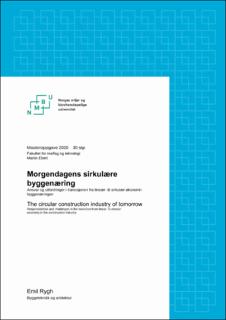| dc.contributor.advisor | Ebert, Martin | |
| dc.contributor.advisor | Forsberg, Franz | |
| dc.contributor.author | Rygh, Emil | |
| dc.coverage.spatial | Norway | en_US |
| dc.date.accessioned | 2020-10-07T11:36:02Z | |
| dc.date.available | 2020-10-07T11:36:02Z | |
| dc.date.issued | 2020 | |
| dc.identifier.uri | https://hdl.handle.net/11250/2681571 | |
| dc.description.abstract | Byggenæringen står for en betydelig andel av det totale materialforbruket og klimagassutslippet i verden. Endringene som må til for å nå Norges nye målsettinger om 50% reduksjon av utslipp innen 2030 og EU kravet om 70% materialgjenvinning for byggavfall i 2020, vil være totalt omveltende for dagens praksis. Overgang til en sirkulær økonomi er en av strategiene som blir foreslått som en del av løsningen. I denne oppgaven er det gjennom litteraturstudie og intervjuer forsøkt å skaffe et overblikk over sirkulærøkonomiens posisjon i dagens byggenæring og de utfordringene næringen står ovenfor i årene fremover.
Sirkulærøkonomi kan overordnet ses som en strategi for å redusere forbruket til et bærekraftig nivå. Begrepet er ikke et nytt, men tankesettet har fått et betydelig økt fokus de siste årene. Det er mange teorier som utgjør kjernen i samtidens sirkulærøkonomi, felles for de fleste av dem er overgangen fra lineære til lukkede og materialeffektive systemer hvor ombruk og høyverdig ressursgjenvinning sørger for at materialene beholder høyest mulig verdi så lenge som mulig. Sirkulærøkonomi har blitt en viktig del av EU sin strategi for å nå målet om nullutslipp innen 2050. Europakommisjonen har utarbeidet handlingsplaner med konkrete målsettinger for å oppnå økt sirkulæritet. Også i Norge har vi ambisjoner om å øke sirkulæriteten. Dette ses både i Regjeringens uttale målsetting om å være et foregangsland i utviklingen av sirkulærøkonomi og i det stadig økende antallet offentlig og private aktører som arbeider med små og store sirkulære prosjekter. Digitalisering er en viktig brikke i transisjonen, brukervennlig digitale verktøy vil kunne fremme samhandling på tvers av aktører og kan bidra til å redusere dagens logistikkutfordringer. Det må utvikles nye verktøy og tilrettelegges for bedre bruk av teknologien det allerede er tilgang på i dag. Systemene bransjen allerede har i dag kan bidra til økt sirkulæritet og for å understøtte dette er det i oppgaven utviklet en prototype bygget opp av eksisterende programvare.
Overordnet konkluderes det med at det nødvendige rammeverket som skal til for å understøtte overgangen fra lineære- til sirkulære løsninger i byggenæringen fortsatt ikke er på plass. Økonomi og lovgivning ses som de to førende parameterne for fremvekst. For å sikre konkurransedyktighet vil det være avgjørende å effektivisere verdikjedene for bruk av sekundærråvarer og ombrukskomponenter. Det er gjennom tverrsektorielt samarbeid og i dialog med offentlige myndigheter overgangen til en regenerativ og materialeffektiv sirkulærøkonomi kan realiseres. | en_US |
| dc.description.abstract | The construction industry accounts for a significant proportion of total material consumption and greenhouse gas emissions in the world. The changes needed to reach Norway's new targets for a 50% reduction in emissions by 2030 and the EU requirement for 70% material recycling for construction waste in 2020 will be abrupt for current practice. Transitioning to a circular economy is one of the strategies proposed as part of the solution. In this paper, an attempt has been made through literature studies and interviews to obtain an overview of the circular economy's position in today's construction industry and the challenges facing the industry in the years to come.
In general, circular economics can be seen as a strategy to reduce consumption to a sustainable level. The concept is not a new one, but the mindset has gained a significant increase in focus in recent years. Many theories are forming the core of today's circular economy, common to most of them is the transition from linear to closed and material-efficient systems where reuse and high-quality resource recovery ensure that materials retain the highest possible value for as long as possible. The circular economy has become an important part of the EU's strategy for achieving the zero-emission target by 2050. The European Commission has drawn up action plans with specific objectives to achieve increased circularity. In Norway, too, we have ambitions to increase circularity. This is seen both in the Government's statement aiming to be a pioneering country in the development of the circular economy and the ever-increasing number of public and private actors working on small and large circular projects. Digitization is an important part of the transition, user-friendly digital tools can promote cross-stakeholder interaction and can help reduce today's logistics challenges. New tools must be developed and facilitated for better use of the technology that is already available today. The systems the industry already has today can contribute to increased circularity and to support this a prototype has been developed based on existing software.
Overall, it is concluded that the necessary framework needed to support the transition from linear to circular solutions in the construction industry is still not in place. Economics and legislation are the two leading parameters for growth. To ensure competitiveness, it will be crucial to streamline the value chains for the use of secondary raw materials and reuse components. Through the cross-sectoral cooperation and in dialogue with public authorities, the transition to a regenerative and material-efficient circular economy can be realized. | en_US |
| dc.language.iso | nob | en_US |
| dc.publisher | Norwegian University of Life Sciences, Ås | en_US |
| dc.rights | Attribution-NonCommercial-NoDerivatives 4.0 Internasjonal | * |
| dc.rights.uri | http://creativecommons.org/licenses/by-nc-nd/4.0/deed.no | * |
| dc.subject | Sirkulærøkonomi | en_US |
| dc.title | Morgendagens sirkulære byggenæring : ansvar og utfordringer i transisjonen fra lineær- til sirkulær økonomi i byggenæringen | en_US |
| dc.title.alternative | The circular construction industry of tomorrow : responsibilities and challenges in the transition from linear- to circular economy in the construction industry | en_US |
| dc.type | Master thesis | en_US |
| dc.subject.nsi | VDP::Teknologi: 500 | en_US |
| dc.source.pagenumber | 93 | en_US |
| dc.description.localcode | M-BA | en_US |

